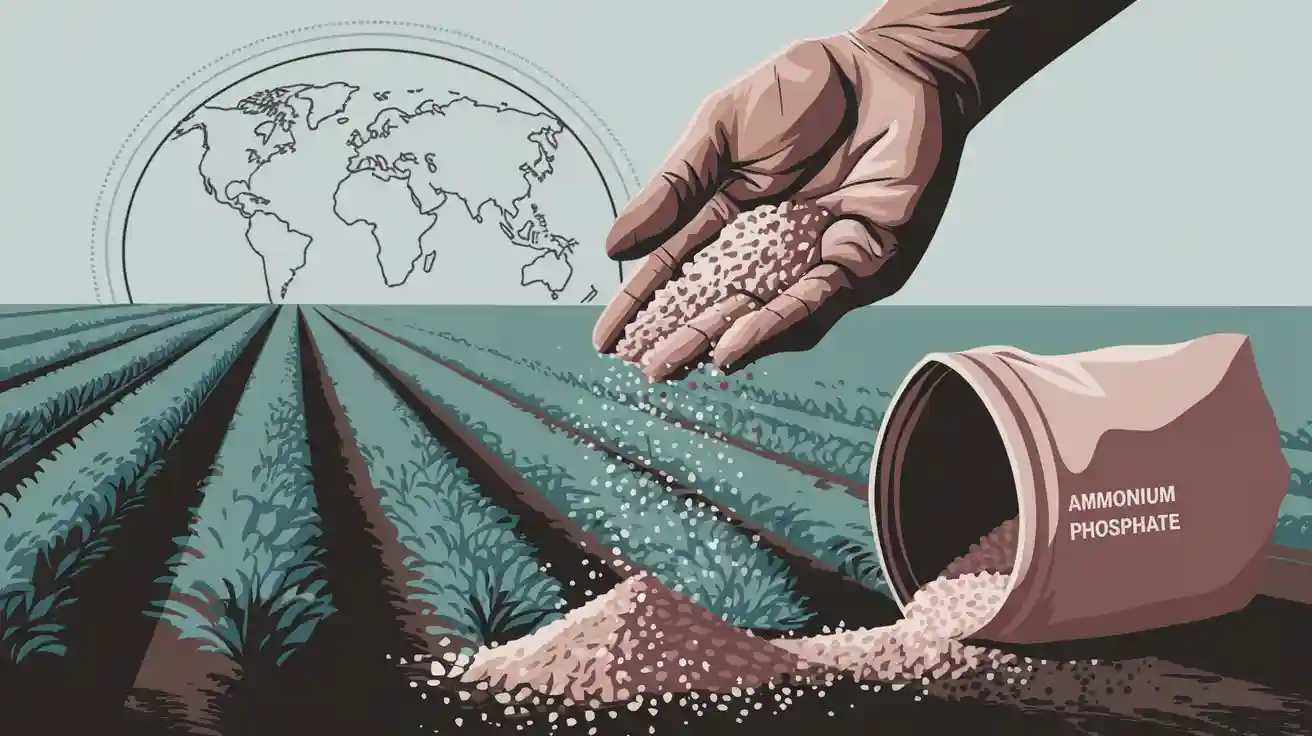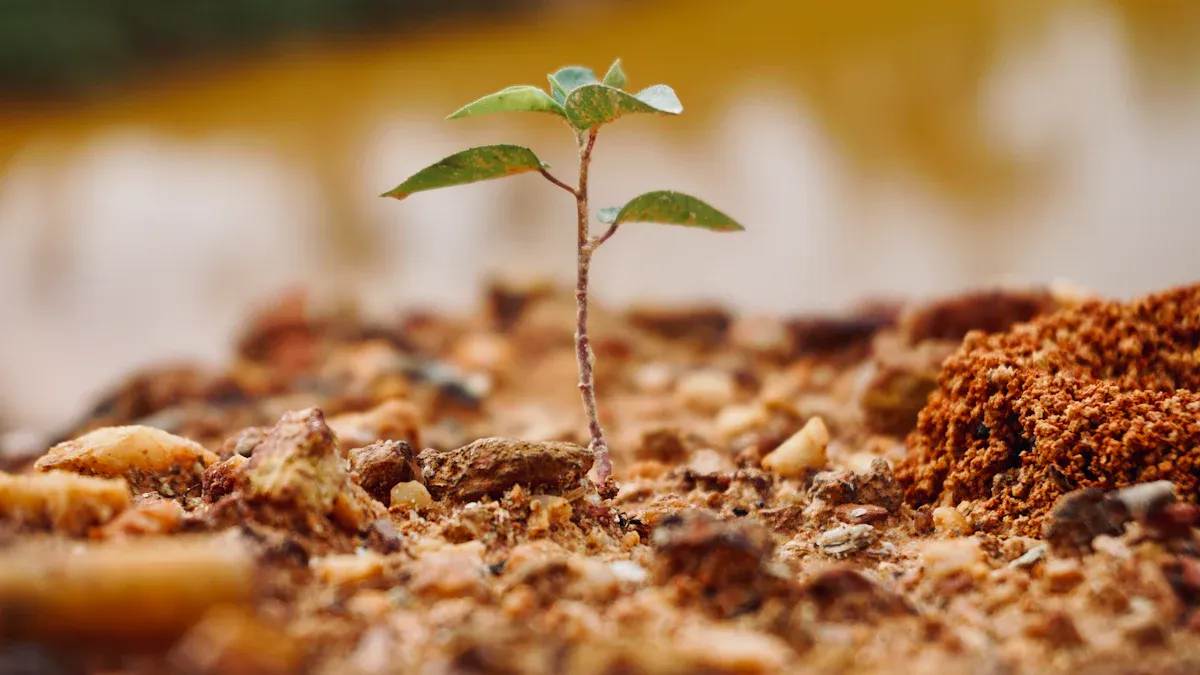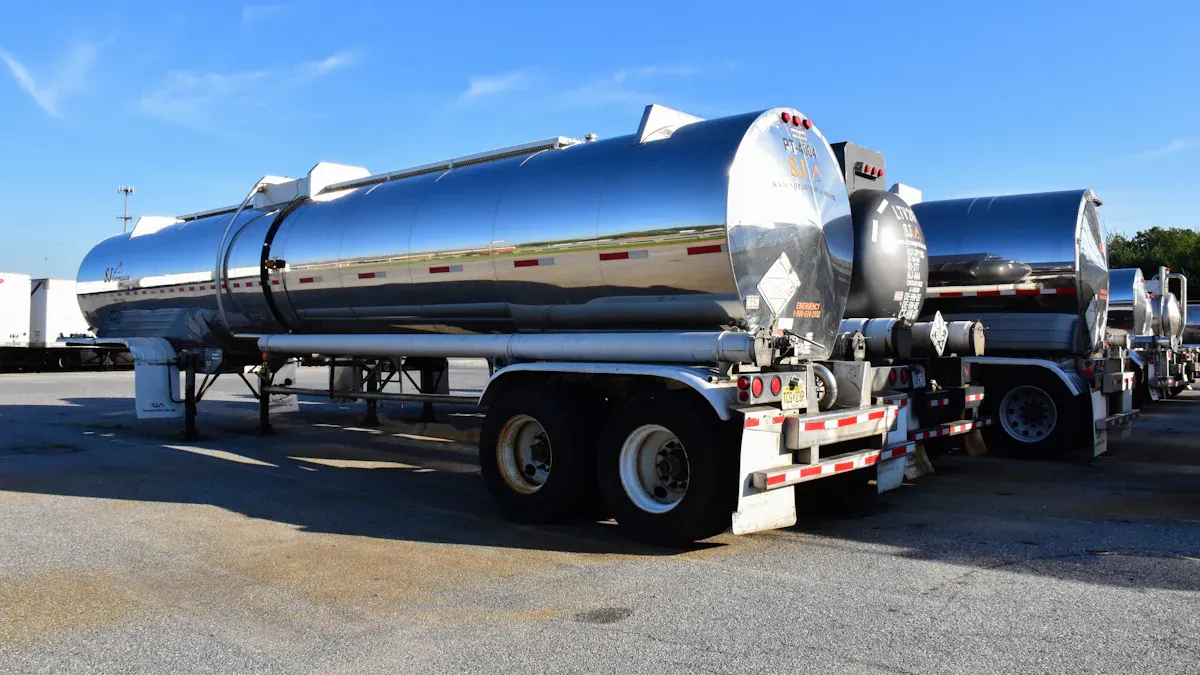Why ammonium phosphate fertilizers are the second largest fertilizer in the world

Ammonium phosphate fertilizers are the second biggest group in the world. These fertilizers give plants both nitrogen and phosphorus. Plants need these nutrients to grow well. Farmers like these fertilizers because plants use them quickly. They also help crops grow better in many places. The table below shows that more than 68 million metric tons are made worldwide. Almost half of the need comes from the Asia-Pacific region.
Fertilizer Type | Global Production Volume (2024, million metric tons) | Regional Demand Share (%) |
|---|---|---|
Monoammonium Phosphate (MAP) | 44.2 | Liked in North America and Europe |
Diammonium Phosphate (DAP) | 22.4 | Most used in Asia-Pacific (61%) |
Total Ammonium Phosphate | >68 (total made), >57 (used in fertilizers) | Asia-Pacific has 48% of the need |
Key Takeaways
Ammonium phosphate fertilizers give plants nitrogen and phosphorus. These nutrients help plants grow strong roots and healthy leaves.
These fertilizers dissolve fast in soil. This lets plants take in nutrients quickly. It helps crops grow better early on.
Using ammonium phosphate fertilizers makes crops grow more. It also makes soil healthier. This helps farmers grow more food in a good way.
These fertilizers work with many crops. They are great for legumes like peas, beans, and soybeans. They also fit many soil types like clay, sandy, and tropical soils.
Farmers can use these fertilizers in many ways. They are easy to store. This makes them simple and handy to use.
Big producers like China, the United States, and India make these fertilizers. They send them all over the world. This helps keep food safe for everyone.
Ammonium phosphate fertilizers give two main nutrients in one product. This is better than urea. It saves farmers time and money.
New ideas and technology are making these fertilizers better. Slow-release fertilizers and digital tools help them work well and stay safe for the environment.
Ammonium Phosphate Fertilizers: Key Benefits
Dual Nutrient Supply
Ammonium phosphate fertilizers are special because they give plants two important nutrients. These nutrients are nitrogen and phosphorus. Plants need both to grow strong roots and healthy leaves. Nitrogen helps plants make proteins and keeps leaves green. Phosphorus helps roots grow deep and supports flowers and energy inside the plant.
Nitrogen and Phosphorus Roles
Nitrogen and phosphorus each help plants in different ways. Nitrogen makes leaves and stems grow bigger and greener. Phosphorus helps roots get stronger and deeper. It also helps plants when they make flowers and seeds. When farmers use ammonium phosphate fertilizers, crops get both nutrients at the same time. This helps plants grow better than if they got only one nutrient. For example, a special ammonium phosphate fertilizer kept more nitrogen and phosphorus in the soil for longer. In greenhouse tests with spring wheat, this fertilizer helped plants take in more nutrients. Plants grew better and made about 15% more grain than with regular fertilizers. Plants also used the nutrients better, so there was less waste and better results.
High Assimilation Rate
Ammonium phosphate fertilizers dissolve fast in soil. This means plants can take in nutrients soon after they are added. Farmers see results quickly, and crops get what they need at the right time.
Rapid Dissolution
One big benefit of ammonium phosphate fertilizers is how fast they release nutrients. When these fertilizers touch wet soil, they break down quickly. This makes nitrogen and phosphate ready for plant roots almost right away. Crops can use these nutrients fast, which helps them grow strong early.
Crop Yield Impact
Ammonium phosphate fertilizers help farmers grow more crops. By giving both nitrogen and phosphorus, these fertilizers help plants at every stage. Crops grow faster, make more food, and recover better from stress.
Soil Fertility Enhancement
Scientists have studied phosphate fertilizers for many years. A study of over 400 tests in Finland showed that phosphorus fertilizers, like ammonium phosphate, raised yields by 11% on average.
The amount of yield increase depended on the soil type. Clay soils had a 5% increase, coarse soils 10%, and organic soils 15%.
Big field tests in Norway, Denmark, and Canada showed yield increases from 7% to 45%. The results depended on local conditions.
These studies show ammonium phosphate fertilizers help crops grow more and make soil better over time. Farmers can often use less phosphorus and still get good yields, which is better for the environment.
Ammonium phosphate fertilizers give crops a steady supply of nutrients. They help plants use nutrients better and keep soils healthy for future crops.
Versatility and Application
Crop Adaptability
Ammonium phosphate fertilizers can be used with many crops. Farmers like them because they work for different plants. Peas grow much better when farmers use di-ammonium phosphate. If farmers use 150 kg per hectare, peas can grow from 730 to 1,720 kg per hectare. Pea roots also get more nodules, which helps them take in more nitrogen from the air. This makes the plants stronger and gives bigger harvests.
Other legumes, like common beans and soybeans, also do well with ammonium phosphate fertilizers. This is very helpful in tropical soils that do not have enough phosphorus. These fertilizers help the plants grow taller and make more pods. The plants also stay healthier. Farmers get the best results when they use the right amount of fertilizer and plant seeds at the right space. Longer rainy seasons help crops grow even more.
Peas: Grow better and have more nodules with the right fertilizer.
Common beans and soybeans: Grow taller and make more pods in tropical soils.
Legumes: Need phosphorus to grow well and use soil nutrients.
Soil Compatibility
Ammonium phosphate fertilizers work in many types of soil. They dissolve fast, so plants can use the nutrients even if the soil is dry. Farmers with clay, sandy, or organic soils see good results. These fertilizers help balance nutrients and make the soil better over time. In tropical places, where soil does not have enough phosphorus, ammonium phosphate fertilizers help crops grow. They make the soil healthy and help roots grow strong.
Note: Ammonium phosphate fertilizers can make soil less acidic if used right. This is good for soils that get too acidic after using other fertilizers.
Ease of Use
Application Methods
Farmers can use ammonium phosphate fertilizers in different ways. They can spread it on top of the soil, mix it in, or put it near seeds when planting. These ways help farmers give the right amount to each crop. Many farmers like to put the fertilizer close to the roots. This helps plants get nutrients fast and stops waste.
Storage Advantages
Ammonium phosphate fertilizers are easy to store and last a long time. They do not take in much water from the air, so they stay dry. Farmers can keep them for a long time without losing quality. This helps both big and small farms plan better.
Tip: Always keep fertilizer in a cool, dry place so it stays good.
Phosphate Fertilizer in Global Agriculture

Major Producing Countries
China, United States, and India
China, the United States, and India make the most phosphate fertilizer. These countries have a lot of phosphate rock. This rock is needed to make phosphate fertilizers. China makes the most and has many factories in different places. The United States is next, with big factories in Florida and the west. India is also important. It uses its own rock and also buys some from other countries.
These countries help their own farmers and send fertilizer to other places. Their strong production keeps world markets steady. Many poorer countries need to buy fertilizer from these top producers. When these countries make more fertilizer, prices can go down. This helps more farmers around the world get what they need.
Country | Main Production Areas | Global Role |
|---|---|---|
China | Sichuan, Yunnan, Hubei | Largest producer/exporter |
United States | Florida, Idaho, North Carolina | Major exporter, technology leader |
India | Rajasthan, Andhra Pradesh | Large consumer/producer |
Market Demand
Food Security Role
Phosphate fertilizer helps farmers grow more food. It gives crops nutrients to grow strong and healthy. Farmers use it so plants can have good roots, green leaves, and lots of food. If crops do not get enough phosphate, they do not grow as well.
Groups around the world say fertilizer is important for food. They explain that fertilizers, like ammonium phosphate fertilizers, give plants what they need to grow. These nutrients help crops be healthier for people and animals.
Phosphorus in phosphate fertilizers helps plants store and move energy. This helps plants grow early, make strong roots, and finish growing.
Phosphorus is also needed for people. It is part of bones, teeth, DNA, and energy in every cell.
Fertilizer helps farmers keep soil healthy and grow crops that can handle hard times.
The Food and Agriculture Organization (FAO) says small farmers need steady fertilizer supplies. These farmers grow most of the world’s food.
If fertilizer is hard to get, crop yields can drop. This can make it hard for many people to get enough food.
Phosphate fertilizer is still very important for feeding people. It helps crops grow well and gives people enough food everywhere.
Comparison with Urea and Other Fertilizers
Nutrient Differences
Ammonium phosphate fertilizers are different from others. They give plants both nitrogen and phosphorus. Urea and most other fertilizers only give nitrogen. This is important for how plants grow and for soil health.
Ammonium phosphate fertilizers, like MAP and DAP, give two nutrients: nitrogen and phosphorus.
Urea and other big nitrogen fertilizers only give nitrogen.
Ammonium phosphate fertilizers help plants grow strong roots and healthy leaves at the same time.
Plants need both nitrogen and phosphorus to grow their best. Nitrogen helps plants grow tall and green. Phosphorus helps roots grow and helps plants make flowers and seeds. When farmers use ammonium phosphate fertilizers, crops get both nutrients in one step. This makes it easier to take care of the soil and helps plants grow better.
Ammonium phosphate fertilizers help farmers avoid missing nutrients. They mean farmers do not have to add extra fertilizer as often. This saves time and money.
Market Position
Urea is the most used fertilizer in the world. Farmers pick it because it has a lot of nitrogen and costs less. Ammonium phosphate fertilizers are the second most used. They are liked because they give both nitrogen and phosphorus in one product.
Fertilizer Type | Main Nutrient(s) | Global Rank | Typical Use Cases |
|---|---|---|---|
Urea | Nitrogen | 1 | Cereal crops, rice, wheat |
Ammonium Phosphate (MAP, DAP) | Nitrogen, Phosphorus | 2 | Grains, legumes, oilseeds |
Potash | Potassium | 3 | Fruits, vegetables, tubers |
Farmers in Asia, North America, and Europe use ammonium phosphate fertilizers for many crops. These fertilizers help crops grow better in places where soil does not have enough phosphorus. Urea is still the top choice for crops that only need nitrogen. Ammonium phosphate fertilizers are best for crops that need both nutrients.
Unique Advantages
Ammonium phosphate fertilizers have special benefits over urea and other fertilizers.
They give both nitrogen and phosphorus in one use.
These fertilizers dissolve fast in soil, so plants can use them right away.
Ammonium phosphate fertilizers work in many soil types, like acidic and sandy soils.
They help soil stay healthy by adding phosphorus, which lasts longer than nitrogen.
Farmers see better plant growth and more crops when they use ammonium phosphate fertilizers on soils that need phosphorus. These fertilizers also mean farmers do not have to add fertilizer as many times during the season.
Tip: Ammonium phosphate fertilizers help farmers save time and grow healthier crops, especially in soils that need both nitrogen and phosphorus.
Production and Supply Chain

Raw Materials
Phosphate Rock
Phosphate rock is very important for making ammonium phosphate fertilizers. This mineral forms slowly from old sea animals or volcanoes. Mining companies dig up phosphate rock from big deposits in some countries. China, the United States, India, Canada, and Brazil mine the most phosphate rock. These countries give most of the raw material for fertilizers around the world.
To make ammonium phosphate fertilizers, factories also need nitrogen. They get nitrogen by taking it from the air and mixing it with natural gas. This makes anhydrous ammonia. This process happens in many places because nitrogen is everywhere in the air.
The table below lists the main raw materials and where they come from:
Raw Material | Description | Global Sources |
|---|---|---|
Nitrogen (N) | Made by mixing nitrogen gas from the air with natural gas to make ammonia. | All over the world (air has lots of nitrogen) |
Phosphorus (P) | Taken from phosphate rock, which comes from old sea or volcano deposits. | China, United States, India, Canada, Brazil |
Phosphate rock gives the phosphorus needed for all phosphate fertilizers. Without this mineral, farmers could not grow enough food for everyone. Nitrogen and phosphorus together help crops grow strong and healthy. These raw materials are very important for farming today.
Manufacturing Process
Factories make ammonium phosphate fertilizers by following steps. First, workers mix ammonia with phosphoric acid. This makes either MAP or DAP. The type depends on how much ammonia is used.
The main steps are:
Preparation of Raw Materials
Workers bring in ammonia and phosphoric acid. They check if each material is good before using it.Chemical Reaction
Ammonia and phosphoric acid meet in a reactor. The mix gets hot and turns into a thick liquid. If they use more ammonia, they get DAP. If they use less, they get MAP.Granulation
The thick liquid goes into a granulator. Machines turn it into small, hard pieces. These pieces are easy to use on farms.Drying and Cooling
The pieces go through dryers. Hot air takes away extra water. Coolers then make the pieces less hot.Screening and Coating
Workers sort the pieces by size. They put a coat on them to stop sticking and dust.Packaging and Storage
The finished fertilizer goes into bags or big containers. Workers keep it in dry places until it is shipped.
Note: Factories follow strict safety rules. They watch temperature, pressure, and chemicals to keep everyone safe.
Step | Purpose | Equipment Used |
|---|---|---|
Mixing | Put ammonia and acid together | Reactor |
Granulation | Make hard pieces | Granulator |
Drying/Cooling | Take out water, cool down | Dryer, Cooler |
Screening/Coating | Sort by size, stop clumps | Screens, Coater |
Packaging/Storage | Get ready to ship | Bagging machines |
Distribution
After making ammonium phosphate fertilizers, companies send them to farms. The distribution has a few main steps.
Bulk Transport
Companies put fertilizer in trucks, trains, or ships. Big shipments go to storage places near farms.Warehousing
Distributors keep fertilizer in dry, airy warehouses. Good storage keeps it fresh and safe from water.Retail and Delivery
Local sellers buy fertilizer from distributors. They sell it to farmers in bags or in bulk. Some companies bring it straight to farms.Global Trade
Big producers like China, the United States, and India send fertilizer to other countries. Trading helps make sure everyone has enough.
Tip: Farmers should buy from trusted sellers. Good storage and handling keep fertilizer safe and useful.
Distribution helps farmers get fertilizer when they need it. Good supply chains help food grow and keep prices steady. Fast delivery means crops get nutrients on time for better harvests and healthy soil.
Economic and Environmental Aspects
Cost-Effectiveness
Ammonium phosphate fertilizers give farmers good value. These fertilizers have both nitrogen and phosphorus in one product. This means farmers do not need to use two different fertilizers. Using just one saves time and work for farmers.
The price of ammonium phosphate fertilizers can change each year. In 2021 and 2022, prices went up a lot. Many big farmers still used them because crop prices were high. These farmers paid more but still made good money. In places with strong markets, the extra crop from these fertilizers is worth the higher price.
Small farmers in poorer countries have a harder time. High fertilizer prices can lower their profits. They may not have enough money to buy all the fertilizer they need. How well the fertilizer works also depends on soil, water, and when it is used. If farmers use the right amount at the right time, they get better crops and make more money.
Planning ahead and using fertilizer the right way helps farmers get the most out of ammonium phosphate fertilizers. These steps help farms make money, even when prices go up.
Sustainability
Farmers and leaders want to use fertilizers that are safe for the earth. Ammonium phosphate fertilizers help make farming more sustainable. They help crops grow well, so farmers can grow more food on less land. This helps keep forests and wild places safe.
Environmental Impact
Ammonium phosphate fertilizers dissolve fast in soil. Plants can use the nutrients soon after they are added. This quick use means less chance of nutrients washing away. When farmers use the right amount, they help stop water pollution in rivers and lakes.
Efficient nutrient use: Plants take in more nitrogen and phosphorus, so less is wasted.
Lower soil acidification: Ammonium phosphate does not make soil as acidic as some other fertilizers.
Reduced environmental footprint: These fertilizers help farmers use land and water better by growing more crops.
Farmers can protect the environment by following good steps. They should test the soil, use the right amount, and not add fertilizer before heavy rain. These actions keep farms and nature safe.
Using fertilizer the right way helps crops, farm incomes, and the planet stay healthy. 🌱
Future Trends
Market Growth
The ammonium phosphate fertilizer market is growing each year. In 2024, it was worth about USD 43.2 billion. By 2033, experts think it will be almost USD 56.4 billion. This means the market will grow by about 3% each year from 2025 to 2033. Farmers everywhere want fertilizers that work better. This need helps the market get bigger.
Many things help this growth. Farmers must grow more food for more people. Governments give rewards to help farmers use better methods. New technology makes fertilizers work better. These things keep the market strong, even if prices change or there are worries about the environment.
The steady growth of the ammonium phosphate market shows it is important for farming around the world. Farmers use these fertilizers to grow more food and get better harvests.
Here are the main reasons for growth:
More people need food
Better fertilizer technology
Government help for farming
Need to use nutrients well
Even with some problems, the future looks good. Companies spend money to find new ideas. They try to make fertilizers safer and better for the earth.
Innovation
Innovation is changing ammonium phosphate fertilizers. Companies make new products that help plants use nutrients better. These products waste less and are safer for nature. For example, slow-release coatings let nutrients reach roots slowly. This stops nutrients from being lost and keeps soil healthy.
Digital tools are also more common now. Farmers use sensors and smart apps to check soil health. These tools help them use the right amount of fertilizer at the best time. This saves money and helps crops grow better.
Some important new ideas are:
Slow-release fertilizers: Give nutrients slowly so plants can use them better.
Enhanced efficiency products: Stop nutrients from being wasted and help soil.
Digital agriculture tools: Use data to help farmers care for crops and use fertilizer.
Tip: Farmers who use new technology and better fertilizers can grow more food and keep their land healthy for the future. 🌱
Innovation will keep making the ammonium phosphate market better. As new problems come up, the industry will find smarter ways and new products.
Ammonium phosphate fertilizers are important because they give plants both nitrogen and phosphorus. This helps crops grow better and produce more food. Farmers everywhere use these fertilizers because they are made and shipped efficiently. They help keep soil healthy and make sure people have enough food when used the right way.
Experts say new ways of making chemicals and steady supplies of phosphate rock make ammonium phosphate fertilizers very important for farming today.
Future Trend | Details |
|---|---|
Market Growth | Demand is expected to go up 4–5.8% each year until 2033 |
Sustainability Focus | More products will be bio-based, slow-release, and follow green rules |
Technology | AI, IoT, and smart tools help use fertilizer better and lower harm |
FAQ
What are ammonium phosphate fertilizers?
Ammonium phosphate fertilizers have both nitrogen and phosphorus. These nutrients help plants grow strong roots and leaves. Farmers use them to get more crops and keep soil healthy.
How do MAP and DAP differ?
MAP has more phosphorus and less nitrogen than DAP. DAP gives more nitrogen. Farmers pick one based on what their crops and soil need.
Are ammonium phosphate fertilizers safe for the environment?
If used the right way, these fertilizers help crops and stop nutrient loss. Farmers should use good steps to keep water clean and stop runoff.
Which crops benefit most from ammonium phosphate fertilizers?
Grains, legumes, and oilseeds grow better with these fertilizers. These crops need both nutrients for strong growth and big harvests.
Can farmers use ammonium phosphate fertilizers in all soil types?
Farmers can use these fertilizers on many soils, like clay, sandy, and organic. Using them the right way helps crops use nutrients well.
How should ammonium phosphate fertilizers be stored?
Keep ammonium phosphate fertilizers in a cool, dry spot. Close bags tight so water does not get in. Good storage keeps them safe and working well.
